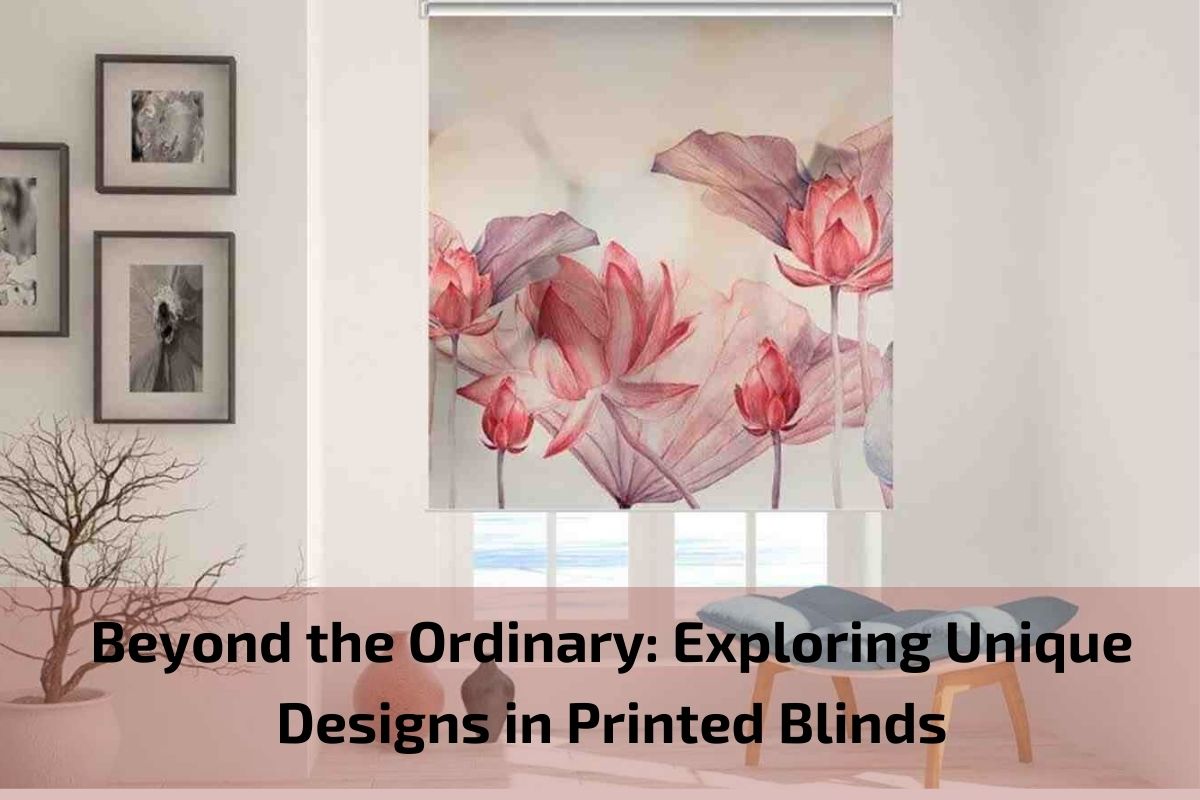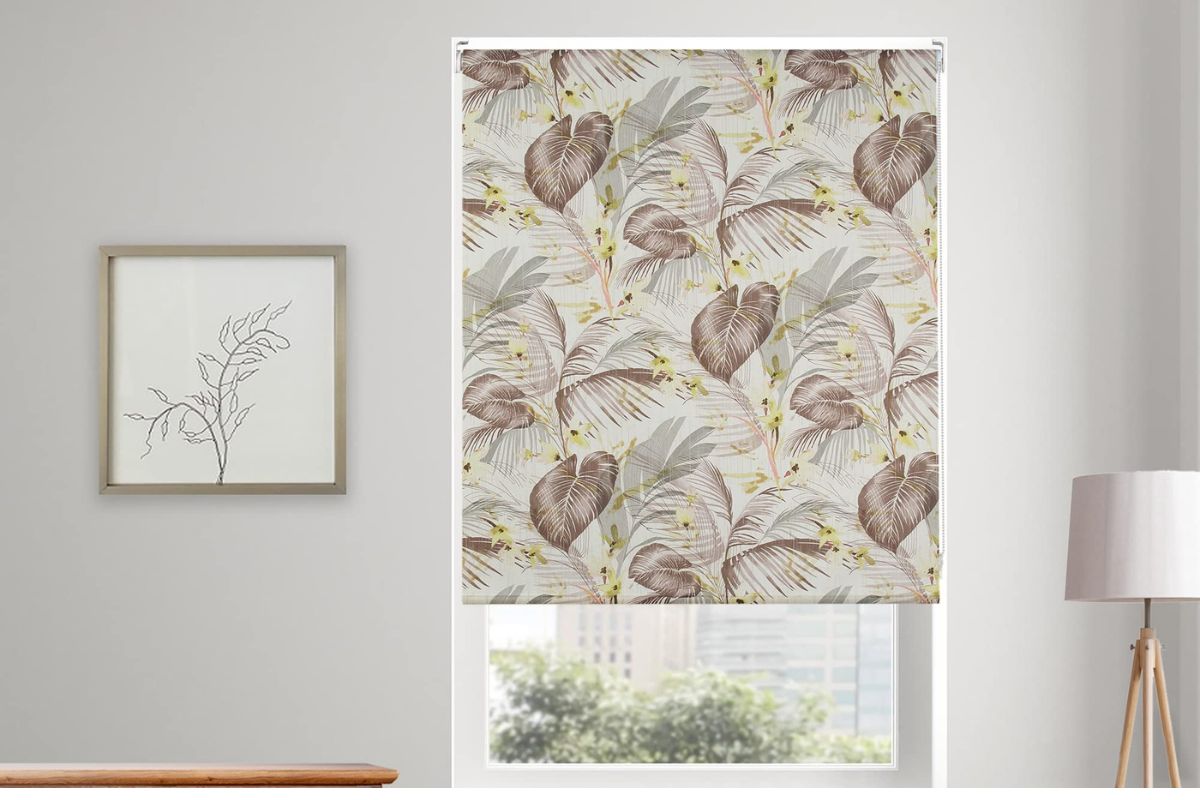In the ever-evolving world of interior design, window treatments play a pivotal role in shaping the ambiance of a space. Among the myriad options available, printed blinds stand out as a bold and innovative choice that goes beyond the ordinary. These window coverings not only serve practical purposes but also double as a canvas for artistic expression, allowing homeowners to infuse their living spaces with unique designs and personalized flair.
In this exploration of “Beyond the Ordinary: Exploring Unique Designs in Printed Blinds,” we delve into the fascinating realm of printed blinds, discovering how they have become a focal point in modern interior design. From captivating patterns to personalized imagery, these window treatments offer a creative avenue for homeowners to redefine the aesthetics of their homes.
Definition and features of printed blinds
Printed blinds are window coverings that feature custom designs, patterns, or images printed directly onto the fabric or material of the blind. This customization allows homeowners and interior designers to add a personal touch to their window treatments, transforming them from mere functional elements to stylish and artistic features within a space. The process typically involves advanced printing technologies that ensure clarity, durability, and vibrant color reproduction.
Key Features of Printed Blinds:
Customization: The defining feature of printed blinds is the ability to personalize the design according to individual preferences. Homeowners can choose from a wide array of patterns, colors, and even incorporate personalized images or graphics onto the blind’s surface.
Versatility: Printed blinds come in various styles and materials, providing versatility to suit different window sizes, shapes, and room aesthetics. This adaptability makes them suitable for a range of settings, from residential homes to commercial spaces.
Aesthetic Appeal: The aesthetic appeal of printed blinds lies in their ability to serve as decorative elements within a room. Whether it’s a subtle pattern that complements existing decor or a bold design that becomes a focal point, printed blinds can significantly enhance the overall aesthetics of a space.
Light Control: Similar to traditional blinds, printed blinds offer control over natural light. Homeowners can adjust the blinds to filter or block sunlight, providing a comfortable and well-lit environment while protecting furnishings from the damaging effects of UV rays.
Privacy: Printed blinds, like their traditional counterparts, provide an effective means of maintaining privacy within a living space. Depending on the material chosen and the level of opacity, these blinds can offer varying degrees of seclusion.
Durability: The printing process is designed to be durable, ensuring that the customized designs on the blinds remain vibrant and clear over an extended period. Quality materials are often used to withstand regular use and environmental factors.
Easy Maintenance: Printed blinds are generally easy to maintain. Regular dusting or light cleaning is usually sufficient to keep them in good condition. Care instructions may vary depending on the specific material used for printing.
Modern Aesthetics: Printed blinds align with modern design trends, allowing homeowners to keep their living spaces current and stylish. The ability to choose contemporary patterns and images makes them a popular choice for those seeking a fresh and updated look.
Different types of printed blinds
There are several types of printed blinds, each offering distinct features and styles to cater to various preferences and functional requirements. Here are some popular types of printed blinds:
Roller Blinds:
Roller blinds are a versatile and practical option for printed designs. The fabric rolls up neatly onto a tube, allowing for easy adjustment of light levels. Printed roller blinds can feature a range of patterns, images, or graphics, providing both functionality and aesthetic appeal.
Roman Blinds:
Roman blinds, with their elegant folds, offer a more tailored and sophisticated look. These blinds can be customized with printed designs, adding a touch of artistry to any room while maintaining the functionality of traditional Roman blinds.
Vertical Blinds:
Vertical blinds are characterized by slats that hang vertically from a headrail. Printed vertical blinds are a modern choice, allowing for the incorporation of patterns or images that span the length of the blinds. They are particularly suitable for larger windows or sliding glass doors.
Venetian Blinds:
Venetian blinds consist of horizontal slats that can be tilted to control light and privacy. Printed Venetian blinds can showcase intricate patterns or images on each slat, adding a unique design element to this classic window treatment.
Panel Blinds:
Panel blinds are often used for larger windows or as room dividers. These consist of large fabric panels that slide across a track. Customization options for printed panel blinds are extensive, allowing for the creation of stunning visual effects.
Pleated Blinds:
Pleated blinds are constructed with neat, folded fabric that forms an accordion-like pattern. These blinds can feature printed designs that stretch across the pleats, providing a decorative touch to the window treatment.
Bamboo or Wooden Blinds:
For a natural and textured look, bamboo or wooden blinds can be customized with printed patterns or images. This option combines the warmth of natural materials with the visual interest of printed designs.
Blackout Blinds:
Blackout blinds are designed to block out light entirely, making them ideal for bedrooms or media rooms. Printed blackout blinds can incorporate stylish designs while offering maximum light control and privacy.
Day and Night Blinds:
Day and night blinds feature alternating opaque and sheer strips that can be adjusted for varying levels of light and privacy. Printed designs on these blinds add a decorative element to the dual-layered fabric.
Smart Blinds:
Incorporating technology, smart blinds can be customized with printed designs while offering remote control or automation features. These blinds can be programmed to adjust based on time of day or personal preferences.
Benefits of Printed Blinds
Printed blinds offer a range of benefits that go beyond mere functionality, adding a touch of personalization and style to any living space. Here are some key benefits of opting for printed blinds:
Aesthetic Appeal:
One of the primary advantages of printed blinds is their ability to enhance the overall aesthetics of a room. With a vast array of design options, homeowners can choose patterns, images, or graphics that complement their decor, creating a unique and visually appealing atmosphere.
Customization:
Printed blinds provide an unparalleled level of customization. Homeowners have the freedom to choose from a wide range of designs, colors, and even incorporate personalized images. This level of customization allows for a truly unique and individualized window treatment.
Versatility:
Printed blinds come in various styles and materials, offering versatility to suit different window sizes, shapes, and room settings. Whether it’s roller blinds, Roman blinds, or vertical blinds, the diverse options cater to different preferences and functional requirements.
Personal Expression:
These blinds serve as a canvas for personal expression. Homeowners can showcase their creativity and personality by selecting designs that resonate with their individual style. This adds a personal touch to the living space, making it more reflective of the occupants’ tastes and preferences.
Enhanced Ambiance:
The right printed blinds can significantly impact the ambiance of a room. Whether creating a calming atmosphere with nature-inspired prints or adding a pop of color with vibrant patterns, printed blinds contribute to the overall mood and feel of the space.
Privacy Control:
Printed blinds, like traditional window treatments, provide effective privacy control. Depending on the material and design chosen, homeowners can achieve varying levels of privacy while still enjoying the benefits of natural light.
Light Management:
These blinds offer effective light management, allowing homeowners to control the amount of sunlight entering a room. Whether diffusing light with sheer printed fabrics or blocking it out completely with blackout options, printed blinds cater to diverse light preferences.
Modern Design Trends:
Printed blinds align with modern design trends, making them a popular choice for those looking to keep their living spaces contemporary and stylish. The ability to choose from the latest patterns and designs ensures that the decor stays up-to-date.
Durability:
The printing process for these blinds is designed to be durable, ensuring that the customized designs remain vibrant and clear over time. Quality materials are often used to withstand regular use and environmental factors.
Increased Home Value:
Upgrading window treatments to include printed blinds can enhance the overall value of a home. Potential buyers often appreciate the attention to detail and personalized features, making the property more appealing in the real estate market.
Installation and Maintenance Tips Printed Blinds
Installation Tips for Printed Blinds
Read the Manufacturer’s Instructions:
Before starting the installation process, thoroughly read the manufacturer’s instructions that accompany the printed blinds. This will provide specific guidance and ensure that you follow the correct steps.
Gather Necessary Tools:
Collect all the tools you’ll need for installation, such as a drill, screwdriver, level, and measuring tape. Having everything ready beforehand will streamline the process.
Measure Twice, Install Once:
Accurate measurements are crucial for a proper fit. Measure the window space carefully, ensuring you account for any obstructions or uneven surfaces. Double-check your measurements before making any cuts or adjustments.
Secure Mounting Brackets:
Install the mounting brackets securely and level. Properly aligned brackets are essential for the smooth operation of the blinds. Use anchors and screws that are suitable for your wall or window frame material.
Handle with Care:
Treat the printed blinds with care during the installation process to avoid any damage to the printed surface. Lay the blinds flat on a clean surface and handle them gently.
Follow a Step-by-Step Approach:
Many printed blinds come with a step-by-step installation guide. Follow the recommended sequence of steps to ensure that each component is installed correctly and in the right order.
Seek Professional Help if Needed:
If you’re uncertain about the installation process or if the blinds are large and heavy, consider seeking professional help. Professional installers have the expertise to handle complex installations efficiently.
Test the Operation:
After installation, test the operation of the blinds by raising and lowering them multiple times. Ensure that the mechanism functions smoothly and that the blinds are aligned properly.
Maintenance Tips for Printed Blinds
Regular Dusting:
Dust the printed blinds regularly using a soft brush or a vacuum cleaner with a brush attachment. This prevents dust buildup and maintains the clarity of the printed design.
Spot Cleaning:
For minor stains or spots, use a mild detergent or a fabric cleaner suitable for the material of the blinds. Gently blot the stained area with a clean, damp cloth, and avoid harsh scrubbing.
Avoid Abrasive Cleaners:
Refrain from using abrasive or harsh chemical cleaners, as they can damage the printed surface and the fabric of the blinds. Stick to gentle, non-abrasive cleaning solutions.
Handle with Clean Hands:
When operating the blinds, ensure your hands are clean. Oils and dirt from hands can transfer onto the printed surface, potentially causing discoloration over time.
Check for Loose Parts:
Periodically inspect the blinds for any loose or damaged parts, such as brackets, screws, or cords. Tighten or replace as needed to maintain the structural integrity of the blinds.
Address Wear and Tear Promptly:
If you notice any signs of wear, such as frayed edges or damaged slats, address the issue promptly. Timely maintenance can prevent minor problems from escalating.
Professional Cleaning Services:
Consider professional cleaning services for a thorough and deep cleaning of your printed blinds, especially if they are heavily soiled or if the manufacturer recommends professional maintenance.
Store Carefully if Removed:
If you need to remove the blinds temporarily, store them in a clean, dry area. Avoid folding or creasing the material, as this can affect the integrity of the printed design.
conclusion
In conclusion, printed blinds emerge not just as functional window treatments but as transformative elements that elevate the aesthetics of any living space. The marriage of customizable designs with practical features makes them a compelling choice for those seeking both style and substance in their home decor.









